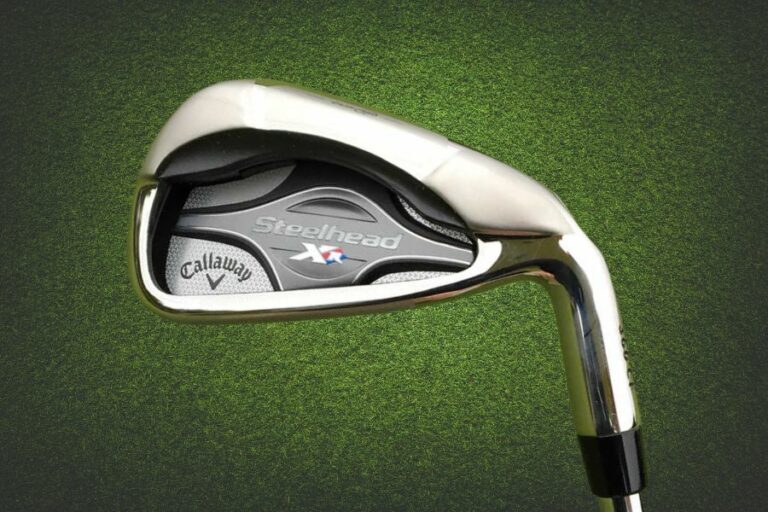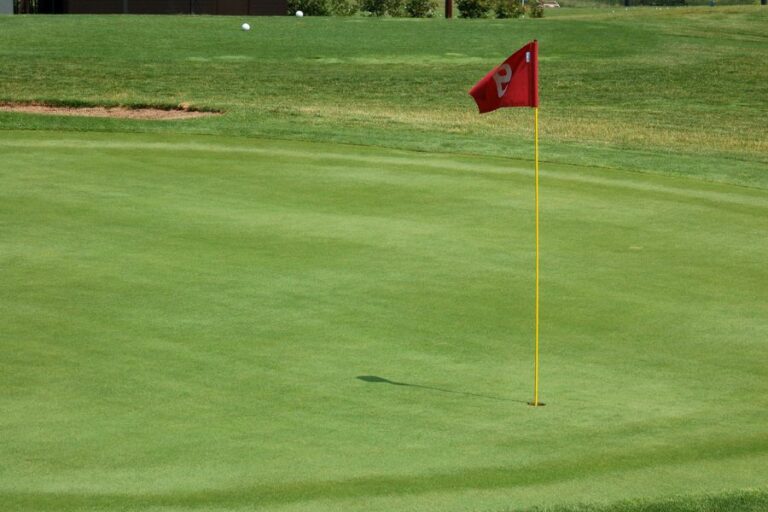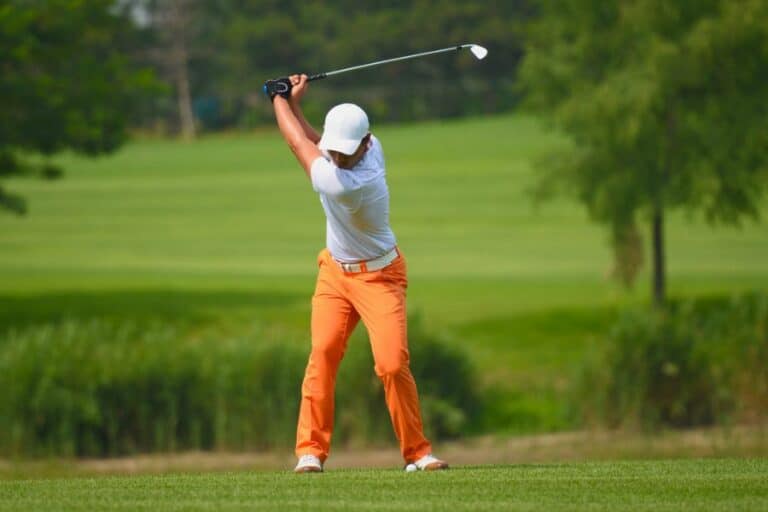How To Hold A Golf Club: Proper Grip For Left & Right Handed

A step-by-step detailed guide to finding out about how to hold a golf club. Find out what are the types of golf grips and what factors affect the grip of a golf club.
The most important part of the golf game is holding a golf club properly for a straight ball flight. This is because the way you hold a golf club determines the outcome of the round and the quality of the swings.
Moreover, if you don’t hold a golf club properly, it may result in discomfort and ultimately result in unfavorable circumstances.
This article looks closely at how to hold a golf club. What are the types of grips? How to grip it if you are a right-handed or left-handed player? In the end, we have even added some tips to help you get a proper hold of your club.
How to hold a golf club?
To hold a golf club, first, you must know how to grip a golf club. Gripping a golf club differs from person to person based on style and comfort. But, the three basic types of golf grips (most popularly used) are:
Ten finger grip
This grip is referred to as a ten-finger grip because all your fingers are placed on the grip of the club. The 10-finger grip is the most basic style and is also commonly known as the Baseball grip or Neutral grip.
If you are a right-handed golfer, the lead hand (left hand) is on the top of the handle, while the trail hand (right hand) is just below it. You need to make sure that there is no gap between the hands such that the knuckles of the left hand are lined up with the knuckles of the right hand. For the left-handed player, this goes vice-versa.
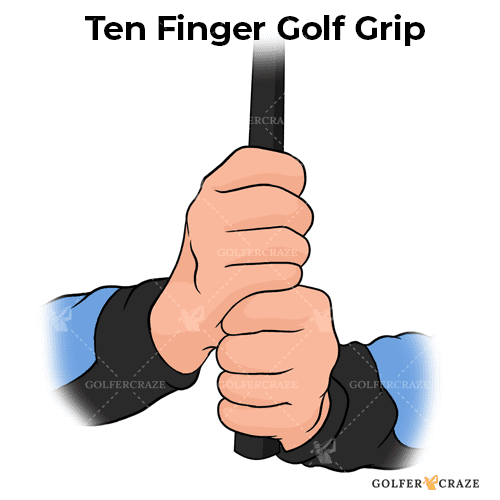
Note: The common mistake that golfers should avoid making in this grip is that the left thumb should not wrap around the golf club’s shaft but should be pointing upwards. That is, it should rest on the club, and the fingers of the right hand should cover it.
Advantages:
- Easy to use, especially for amateurs and beginners, as it is very simple and impactful.
- More wrist flexibility and maximum grip hand contact help achieve more powerful shots and longer distances.
- Feels natural as it is comfortable and helps you get a more relaxed stroke.
Disadvantages:
- Hands can operate independently as the hands are not really connected and move independently, irrespective of each other. This could ultimately cause power imbalance and can mess up the swing sequence.
- Too much freedom in the wrists can affect control and accuracy.
The Interlocking Golf Grip
This type of grip is a popular choice by top PGA Tour players, especially Tiger Woods, Jack Nicklaus, and Rory Mcllroy. The interlocking grip is the same as the ten finger grip, but the only difference is that the pinkie finger of the right hand and the index finger of the left-hand lock together. Let’s check out some of its advantages and disadvantages.
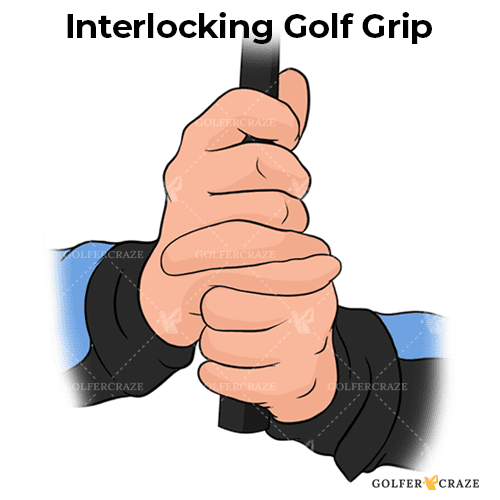
Advantages:
- It suits well for golfers with small hands as it provides comfort, proper golf grip, and for longer distance shots.
- This helps both hands to work together and act as a single unit for a better swing speed.
- It reduces tension on the club due to the interlocking grip pressure and allows a more fluid swing.
Disadvantages:
- Not suitable for golfers with big hands.
- Less wrist movement leads to minimizing power and accuracy.
Vardon Overlap golf grip
This grip style is one of the most common types of grip used by golfers worldwide. The overlapping grip is also known as the “Vardon Overlap grip,” It was first discovered in the early 20th century by a British golfer – Harry Vardon, as a new technique.
But later on, well-known professional golfers such as Phil Mickelson, Arnold Palmer, and Ben Hogan used this grip.
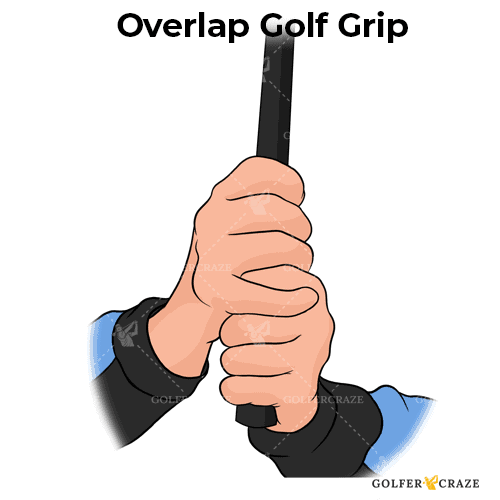
This grip is a combination of the above two grips except that the pinky finger of the trail hand is placed on top of the lead hand so that it lies between the middle finger and forefinger without any gap.
Note: The ring finger of the trail hand should position just beside the lead hand’s index finger while being in contact with the shaft.
Here are some of the advantages and disadvantages of this grip type:
Advantages:
- An overlapping golf grip is a combination of freedom and control as both hands work together without affecting their freedom entirely.
- It’s good for golfers with bigger hands and is more comfortable.
- It is a great choice for improving accuracy.
Disadvantages:
- The only drawback is that it is not suitable for golfers with small hands as it doesn’t give them more power and comfort.
Step-by-step proper golf club grip guide for beginners
Now that you are well aware of the types of golf grips, you need to know how to hold a golf club properly without affecting golf swing speed and have a consistent golf grip.
It doesn’t matter what grip style you use, but if it is not used properly, it can affect your game, and you cannot hit the golf ball straight.
Therefore, follow some quick and easy steps to get a perfect golf grip and proper golf shot:
How to hold a golf club Right Handed?
Here are some of the steps that you need to follow as a right handed golfer:
- Initially, hold your golf club in front of you at waist height with the clubface square and parallel to the fairway.
- Use your left hand to pick up the club and stretch out your fingers. To align the club handle with your left palm, check that there’s a straight line running diagonally across your fingers into your palm.
- Place your hand on the golf club handle so that your bottom palm rests against the top of the club, with only the upper part of the handle visible.
- Take your left hand and rotate it so that only two knuckles are visible when you look down. This is a neutral golf grip, which is advised as the starting position for novices.
- Finally, place your right hand over your left thumb, with the bottom of the palm covering the top. Your right arm should now be covering your left arm.
- Close your right fist. The tip of your thumb and forefinger should make a “V” shape pointing toward your belly button. Your hands should not hang off the handle in any way.
- You’re all set to swing!
How to hold a golf club Left handed?
Left-handed golfers can follow the same steps mentioned above just by changing the hand placements. The right-hand position is close to the edge of the handle, and the left-hand position is close to the ball.
Golf club grips classification
Many novice golfers get confused about which type of golf grip to choose and how a type of golf grip is classified. As we mentioned, there are three types of grips, but each grip is classified as strong, weak, and neutral.
However, these terms do not mean how strong or weak the grip is held, but it refers to how the hands and club face are rotating.
Strong golf grip
A strong grip is one where your hands are turned further clockwise on the club, with your palms facing each other. With a strong golf grip, the hands are rotated away from the target so that the club face returns to the ball in closed form.
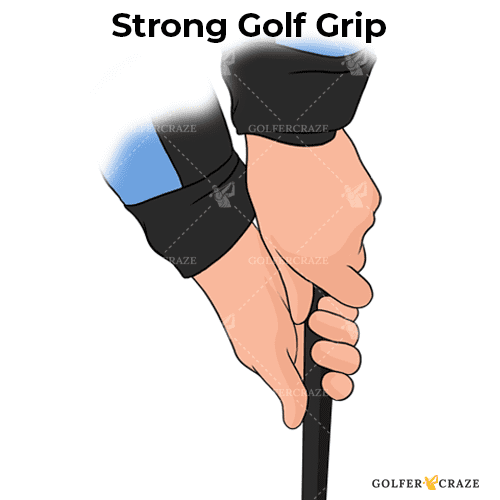
The strong grip helps to keep the club face square to the target line throughout the swing path. It also helps golfers to fix golf hooks. A strong grip can also help you hit the ball further, but it can also make it harder to control your shots.
Weak grip
A weak grip is the opposite, where your hands are turned counter-clockwise on the club. The weak golf grip means that the hands are rotated towards the target such that the club face returns back to the ball in open form. This allows greater rotation of the club face and of the hands. A weak grip can make it easier to control your shots, but you won’t be able to hit the ball as far.
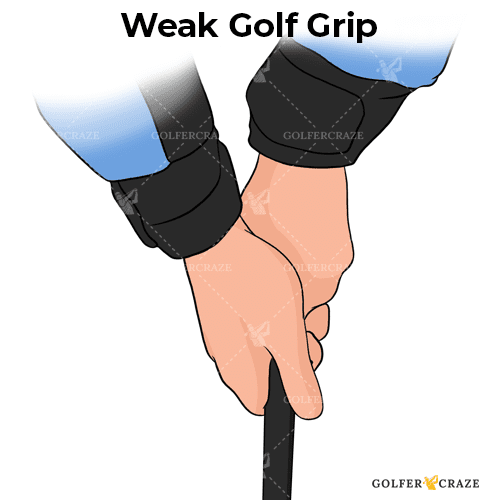
Neutral golf grip
A neutral grip is somewhere in between the two – Weak and Strong Grip. In this grip, the hands are in a neutral position, and the club face returns back to the square position where it started.

Note: Moreover, the neutral grip is highly recommended over the other grips.
How far to grip a golf club?
The most common error that every amateur usually makes is holding the grip too far or too close. Therefore, it becomes necessary to know how far you need to grip the golf club to avoid losing control and hitting the balls with the club’s heel.
So, to avoid all these errors and play golf as a pro, you need to place your upper hand one inch away from the edge of the handle. This lets you maintain a firm grip on the club and helps swing your hands free throughout the golf shots.
Moreover, you need to keep in mind that this is not mandatory to hold a golf club this far, but you need to be comfortable and should struggle while maintaining the grip.
Holding a driver vs. holding a putter
There are different types of golf clubs that are used as per the needs of the golfers. It is obvious that you don’t hold a driver in the same way as the putter. Therefore, the proper golf grip doesn’t change much except in the case of grip used to tee off and while putting the ball into the green.
Holding a Driver
If you are preparing to shoot off the tee, then start by holding the club at the edge of the handle with the left hand. Place the other hand’s index finger and middle fingers such that the knuckles are visible. It overlaps the middle finger and ring finger of the left hand.
Moreover, the right-hand thumb and index finger should create a V shape by lining up with the sternum. For left-handed golfers, reverse the hands.
Holding a Putter
You need to hold the club with your left hand outstretched when putting the ball. You need to place the right hand just below the left. Make sure that the handle is lined up with the center of the hand.
Moreover, other than regular golf swings, putter grips vary a lot. It can overlap, claw, and cross-handed grips. So, for left-handed players, place the hands opposite to the ones mentioned earlier.
Tips for a perfect golf grip to have better shots
Here, we have summed up some factors that can affect how you hold a golf club. So, just by keeping these tips in mind, you can hold the golf club correctly.
1. Grip Material
Nowadays, golf grips are commonly made of rubber and sometimes leather. Some grips have cords that help to reduce slippage and enhance the hold, but some have ribs, which are commonly called a reminder by golfers because these grips help them know proper finger/ hand placement so you can choose which grip feels right for you.
2. Hand Placement and Grip caps
All grips have a cap at the end of the shaft, or at least a ring is used to indicate the cap over the end. This gives you an idea of where the shaft ends and where to place your hand. However, setting your hand below this increases the maximum surface area of the hands with enhanced control and accuracy.
3. Grip Size
This is the measure of the circumference of the grip. The size can be changed based on the type of grip, and the number of wraps of adhesive tape applied to the shaft under the grip.
Moreover, in general, the recommended size fit is when the golfer’s hands get appropriately placed on the club with the fingertips of the top hand touching the base of the thumb of the same hand.
Note: If the grip size is too small, you may end up with the fingers getting gouged into the base of the thumb. This can make you feel uncomfortable and decrease control over the club head.
But, if the grip size is too large, then the top hand will not cover the circumference and end up with the thumb not being in contact with the fingers. This also ultimately results in reduced control and proper release of the club.
4. Grip Pressure
Besides grip material and size, the most important factor which can also affect your grip is grip pressure. So, you need to make sure that you apply the correct golf grip pressure so that the club doesn’t slip out of your hand during the swing. Moreover, when applying pressure, ensure that the shoulder, hand, wrist, and arms all remain relaxed and flow throughout the golf swing.
Pressure Points
To get a good grip when holding a golf club, there are a few things that you need to keep in mind. First and foremost, hold the club primarily with your fingers instead of your palms, as this gives you better control.
Apply pressure evenly between your thumb and index finger while making a small pinch at the bottom of the grip.
Additionally, you should place your thumbs on top of the grip to help stabilize the club and prevent it from twisting during your swing. When placing your hands on the grip, make sure that they are in a neutral position with neither hand dominating.
The Pro’s Advice on Grip Pressure
Professional golfers typically suggest that golfers should hold the golf club with a light to moderate grip pressure, usually around 5 to 7 on a scale of 10, where 10 represents the tightest grip possible.
However, this grip pressure value may vary depending on the shot being played, the club used, and the course conditions. For example, if you are using fairway woods or a driver to play your shot, you need to put light grip pressure. This can help achieve greater flexibility and smoother swings by reducing tension and fatigue in the hands and arms.
It’s important to practice and experiment with different grip pressures to find the most comfortable one for you. Holding the club with the proper pressure points can improve your accuracy, power, and consistency in your golf swing.
How to Fix Ball Flight with the Grip?
Your golf ball flight can be greatly influenced by your grip on the club. Below are some important steps to follow to improve your overall game.
How to fix slice:
To fix a slice, try gripping the club slightly stronger with your lead hand in order to create a draw shot. Also, ensure that your shoulders are aligned with your target line.
How To Fix Hook:
To fix a hook, you should use a weaker grip. With this approach, the right hand may control the club more effectively and aid in producing a fade shot. Reduced clubface twisting is another benefit of using a weaker grip, which produces shots that are more reliable and potent.
When striking a hook shot, proper alignment is just as important as the grip. It is easier to hit your target when the ball is struck cleanly and accurately due to proper alignment. By using these tips, you can improve your hook shot and your overall golfing experience.
How To Fix Fade:
Reduced timing and wrist action are all that’s needed to hit a power fade shot. A golfer needs to open the clubface at contact in order to execute a fade shot correctly. The ball will travel straight if the face is square, whereas it will curve to the left if the face is closed.
It’s recommended to hold the club with your left hand and apply extra pressure with that hand when it comes to grip. This aids in preventing wrist rolling and can increase the accuracy of the shot on the course.
How to Fix Draw:
Making a draw shot can be difficult if you have an unstable grip. It is advised to use a neutral grip because this type of grip makes it simpler to shallow the golf club and attack the ball from an inside swing path. Golfers may enhance their draw stroke and improve their success on the course by adhering to these best practices.
Read More: Draw vs. Fade
Long Thumb Grip Vs Short Thumb Grip
When it comes to achieving optimal control and range in your golf swing, the position of your thumb can make a significant difference.
1. Long Thumb Grip
A long thumb grip means your thumb runs vertically down the shaft, creating more range of motion. This position also separates the thumb from the other four fingers on the hand holding the club.
2. Short Thumb Grip
A short thumb grip means the thumb goes down the right side of the shaft and ends up just beyond the forefinger on that hand. This grip restricts range of motion.
Note: The position of your thumb can affect your clubhead speed and the control of your golf club during your backswing.
Conclusion
Now that you know how, where, and the types of golf grips and how to hold them properly. When you hold it right, you get it right. So, now you are all set to perform better on the course and get straighter shots.
FAQ’s
What are the best golf grips?
It’s crucial to pick the grip that meets your demands from the various available shapes and sizes. Modern grips use cutting-edge technology that can improve your connection and feel with the golf ball. Some of the top golf grips you can try in 2023 include Golf Pride MCC Grip, Golf Pride CPX Grip, Lamkin Sonar+ Tour Calibrate Grip, and more.
Why do golfers need to interlock their fingers?
Interlocking fingers while holding a golf club creates a more secure and stable grip. This grip helps the hands work together, providing better control over the club during the swing. It is particularly useful for golfers with smaller hands or weaker grip strength.
What does choke-down mean in a gripping golf club?
The term choke-down in golf refers to the technique in which the golfer grips the club more closely to the clubhead than usual. For shots that need to go a shorter distance, like chip shots or shots from the rough, this approach is utilized to increase control and accuracy. The golfer shortens the length of the club by gripping it lower on the shaft, which also shortens the swing and enables more accurate shots.
What is the easiest golf grip to learn?
Every golfer has different strengths and weaknesses. Therefore the grips may vary. However, the easiest golf grip for beginners to learn is the baseball grip or overlap grip. This grip enables them to place their hands correctly on the golf club, resulting in a relatively square clubface at impact with the ball and the desired amount of curve.



